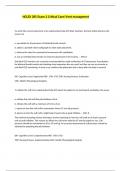Exam (elaborations)
NCLEX 285 Exam 2 Critical Care/Vent managment
To verify the correct placement of an endotracheal tube (ET) after insertion, the best initial action by the nurse is to a. auscultate for the presence of bilateral breath sounds. b. obtain a portable chest radiograph to check tube placement. c. observe the chest for symmetrical movement with ...
[Show more]



